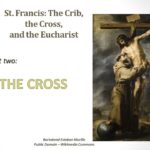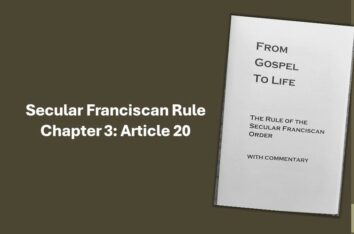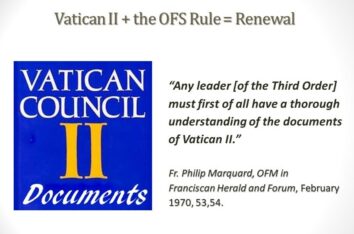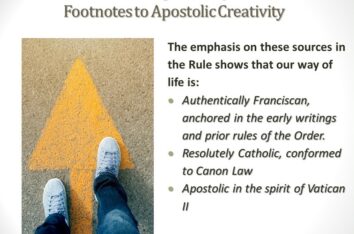Dear Brothers and Sisters,Francis always strove to conform himself to Jesus. He meditated on the passion with careful attention. Every single deed of Jesus, he examined in detail. “The Cross of Jesus was his heart’s food, in which he delighted”.In today’s lesson on the Cross, we will meditate on the Cross through Francis’ perspective and discuss our thoughts at the end of the lesson with our fraternities. If you want to learn more about the Cross go to Franciscan Intellectual Tradition www.franciscantradition.org/resources/other-resources which is loaded with tons of materials on St Francis. Peace, Dona+++++++++++++++++++++++++++++++++++++++++++++++++++++++++++++++++++++++++++++++
St. Francis centered his life and spirituality on the Incarnation, the humanity of Christ. He was in awe that God “bent down” to be with us through his birth; through his suffering and death on the cross; and through the Eucharist by which he remains with us for all time. Usually, we speak about the Crib, the Cross, and the Eucharist in that order. As we move toward Advent, let’s reverse the order. For week two of our series of three reflections, we will consider the middle anchor of the three, through the words of and about St. Francis taken from the sources: THE CROSS.
+++++++++++
++“O Lord Jesus Christ, two graces do I ask of thee before I die;
- the first, that in my lifetime I may feel, as far as possible, both in my soul and body, that pain which thou, sweet Lord, didst endure in the hour of thy most bitter Passion;
- the second, that I may feel in my heart as much as possible of that excess of love by which thou, O Son of God, were inflamed to suffer so cruel a Passion for us sinners.”
From The Little Flowers of St. Francis of Assisi-Third Consideration on the Stigmata (p. 167). Kindle Edition.
++“ A few days had passed when, while he was walking by the church of San Damiano, he was told in the Spirit to go inside for a prayer. Once he entered, he began to pray intensely before an image of the Crucified, a which spoke to him in a tender and kind voice: “Francis, don’t you see that my house is being destroyed? Go, then, and rebuild it for me.” Stunned and trembling, he said: “I will do so gladly, Lord.” For he understood that it was speaking about that church, which was near collapse because of its age. He was filled with such joy and became so radiant with light over that message, that he knew in his soul that it was truly Christ crucified who spoke to him.
14From that hour, therefore, his heart was wounded and it melted when remembering the Lord’s passion. While he lived, he always carried the wounds of the Lord Jesus in his heart. This was brilliantly shown afterward in the renewal of those wounds that were miraculously impressed on and most clearly revealed in his body.
Once he was walking by himself near the church of Saint Mary of the Portiuncula, weeping and wailing loudly. A spiritual man, overhearing him, though he was suffering some sickness or pain. Moved by pity for him,c he asked why he was crying. “I am crying because of the Passion of my Lord,” he said, “for whom I should not be ashamed to go throughout the world crying in a loud voice.” From The Legend of the Three Companions FA: ED, vol. 2, 76
Frequently, even when he got up from prayer, his eyes seemed full of blood because he was crying with such bitterness. But, in memory of the Lord’s passion, not only did he afflict himself in tears, but he also did so by abstaining from food and drink.” From The Legend of the Three Companions FA: ED, vol. 2, 76
++11” His Father’s will was such that His blessed and glorious Son, Whom He gave to us and Who was born for us, should offer Himself through His own blood as a sacrifice and oblation on the altar of the cross: 12not for Himself through Whom all things were made, Jn 1:3 but for our sins, 13leaving us an example that we might follow His footprints.” 1 Pt 2:21
FA: ED, vol. 1, 46 Later Admonition and Exhortation++“Francis perceived the cross to be the highest expression of the humility – the minority – of God. The cross represented the lowest, humblest act of divinity in that Christ lowered himself all the way to the crucifixion at Calvary: “and being found in the appearance of a man, he humbled himself, and became obedient unto death, even the death of the cross (Philippians 2:8).” From Thoman, Bret. A Knight and a Lady: A Journey into the Spirituality of Saints Francis and Clare (Kindle Locations 1052-1055). Kindle Edition.
++7” In the same way, even if you were more handsome and richer than everyone else, and even if you worked miracles so that you put demons to flight: all these things are contrary to you; nothing belongs to you; you can boast in none of these things. 8But we can boast in our weaknesses 2 Cor 12:5 and in carrying each day the holy cross of our Lord Jesus Christ. Lk 14:27” FA: ED, vol. 1, 131 Admonition V- Let No One Be Proud, but Boast in the Cross of the Lord
To discuss or comment on in your journal.
- +Consider the picture: Francis and the Crucified Christ by Esteban Murillo and the quotes given above.
- Comment on:
–The passion and death of Christ in Francis’s life
–The cross in our lives as Secular Franciscans
- +When you contemplate the cross, how do you see yourself in that “mirror?”
+++++++++++++++++++++++++++++++
San Francisco y la Eucaristía, la Cruz y el Pesebre. (Segunda parte: LA CRUZ) (Si quiere seguir los enlaces, abra el documento PDF adjunto)
San Francisco centró su vida y espiritualidad en la Encarnación, la humanidad de Cristo. Estaba asombrado de que Dios “se inclinara” para estar con nosotros durante su nacimiento; por su sufrimiento y muerte en la cruz; y a través de la Eucaristía por la que permanece con nosotros para siempre. Por lo general, hablamos del Pesebre, la Cruz y la Eucaristía en ese orden. A medida que avanzamos hacia el Adviento, invirtamos el orden. Para la segunda semana de nuestra serie de tres reflexiones, consideraremos el ancla intermedia de las tres, a través de las palabras de y sobre San Francisco tomadas de las fuentes: LA CRUZ.
++ “Señor mío Jesucristo, dos gracias te pido me concedas antes de mi muerte: la primera, que yo experimente en vida, en el alma y en el cuerpo, aquel dolor que tú, dulce Jesús, soportaste en la hora de tu acerbísima pasión; la segunda, que yo experimente en mi corazón, en la medida posible, aquel amor sin medida en que tú, Hijo de Dios, ardías cuando te ofreciste a sufrir tantos padecimientos por nosotros pecadores.” http://franciscanos.org/florecillas/llagas2.htm
++ “A los pocos días, cuando se paseaba junto a la iglesia de San Damián, percibió en espíritu que le decían que entrara a orar en ella. Luego que entró se puso a orar fervorosamente ante una imagen del Crucificado, que piadosa y benignamente le habló así: «Francisco, ¿no ves que mi casa se derrumba? Anda, pues, y repárala». Y él, con gran temblor y estupor, contestó: «De muy buena gana lo haré, Señor». Entendió que se le hablaba de aquella iglesia de San Damián, que, por su vetusta antigüedad, amenazaba inminente ruina. Con estas palabras fue lleno de tan gran gozo e iluminado de tanta claridad, que sintió realmente en su alma que había sido Cristo crucificado el que le había hablado.
Saliendo de la iglesia, encontró a un sacerdote sentado junto a ella, y, metiendo la mano en su bolsa, le ofreció cierta cantidad de dinero, diciéndole: «Te ruego, señor, que compres aceite y cuides de que luzca continuamente una lámpara ante este crucifijo. Y, cuando se acabe este dinero, yo te daré de nuevo lo que fuere necesario para lo mismo».
14. Desde aquel momento quedó su corazón llagado y derretido de amor ante el recuerdo de la pasión del Señor Jesús, de modo que mientras vivió llevó en su corazón las llagas del Señor Jesús, como después apareció con toda claridad en la renovación de las mismas llagas admirablemente impresas en su cuerpo y comprobadas con absoluta certeza.
Un día iba solo cerca de la iglesia de Santa María de la Porciúncula llorando y sollozando en alta voz. Un hombre espiritual que lo oyó, pensó que sufriría alguna enfermedad o dolor. Y, movido de compasión, le preguntó por qué lloraba. Y él le contestó: «Lloro la pasión de mi Señor, por quien no debería avergonzarme de ir gimiendo en alta voz por todo el mundo». Y el buen hombre comenzó, asimismo, a llorar, juntamente con él, también en alta voz.
Muchas veces, cuando se levantaba de orar, aparecían sus ojos recargados de sangre, porque había llorado amargas lágrimas. Y no sólo se afligía llorando, sino que se privaba de comida y de bebida en memoria de la pasión del Señor.
http://www.franciscanos.org/fuentes/leyendatrescom01.html++ 1Y la voluntad del Padre fue que su Hijo bendito y glorioso, que él nos dio y que nació por nosotros, se ofreciera a sí mismo por su propia sangre como sacrificio y hostia en el ara de la cruz; 12no por sí mismo, por quien fueron hechas todas las cosas (cf. Jn 1,3), sino por nuestros pecados, 13dejándonos ejemplo, para que sigamos sus huellas (cf. 1 Pe 2,21). http://franciscanos.org/esfa/ctaf2.html (Carta a los fieles)
++ “Francisco percibió la cruz como la máxima expresión de la humildad – la minoría – de Dios. La cruz representó el acto de divinidad más bajo y humilde en el sentido de que Cristo descendió hasta la crucifixión en el Calvario: “y habiéndose hallado en la apariencia de un hombre, se humilló a sí mismo y se hizo obediente hasta la muerte, la muerte de la cruz (Filipenses 2: 8) “. De Thoman, Bret. Un caballero y una dama: un viaje a la espiritualidad de los santos Francisco y Clara (ubicaciones de Kindle 1052-1055). Versión Kindle. (Sólo en inglés)
++7De igual manera, aunque fueras más hermoso y más rico que todos, y aunque también hicieras maravillas, de modo que ahuyentaras a los demonios, todas estas cosas te son contrarias, y nada te pertenece, y no puedes en absoluto gloriarte en ellas; 8por el contrario, en esto podemos gloriarnos: en nuestras enfermedades (cf. 2 Cor 12,5) y en llevar a cuestas a diario la santa cruz de nuestro Señor Jesucristo (cf. Lc 14,27).[Admoniciones Cap. V: Que nadie se ensoberbezca, sino que se gloríe en la cruz del Señor] http://franciscanos.org/esfa/adm-ae.html
Para platicar o comentar en su diario.
+ Considere la imagen: Francisco y Cristo crucificado de Esteban Murillo y las citas que se dan arriba.
Comentar en
–La pasión y muerte de Cristo en la vida de Francisco
–La cruz en nuestras vidas como franciscanos seglares
+ Cuando contemplas la cruz, ¿cómo te ves en ese “espejo?”
Diane F. Menditto, OFSChair, National Formation Commission
Formation Director, Our Lady of the Angels Region
Formation Director, St. Francis Fraternity, Hackensack, NJ



